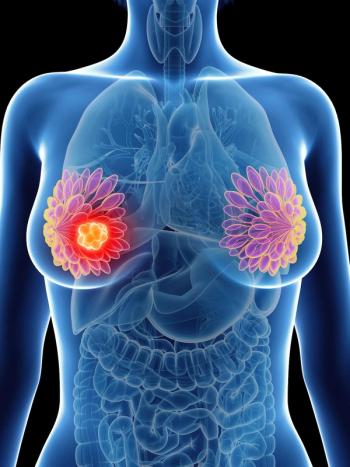
Oncology NEWS International
- Oncology NEWS International Vol 11 No 4
- Volume 11
- Issue 4
HER-2 Predicts Efficacy of Hormonal Therapy in Breast Cancer
SAN ANTONIO-In first-line hormonal therapy for advanced breast cancer, elevated levels of HER-2/neu predict lower response rates and shorter time to disease progression, compared with normal HER-2 levels, according to a large international study.
SAN ANTONIOIn first-line hormonal therapy for advanced breast cancer, elevated levels of HER-2/neu predict lower response rates and shorter time to disease progression, compared with normal HER-2 levels, according to a large international study.
Allan Lipton, MD, professor of medicine and oncology, Pennsylvania State University, Hershey, presented the findings at the 24th Annual San Antonio Breast Cancer Symposium (abstract 6).
The study was part of a phase III study comparing the aromatase inhibitor letrozole (Femara) with tamoxifen (Nolvadex) as first-line therapy in 907 postmenopausal women with advanced breast cancer. That study found a significant benefit for letrozole.
The companion study reported by Dr. Lipton used the Bayer Immuno 1 automated assay to determine HER-2 levels in pretreatment serum samples from 566 of the 907 participants.
The objective response rate according to HER-2 status, irrespective of treatment, was significantly higher in HER-2-negative than in HER-2-positive patients. Overall response rate was 31% vs 15%; clinical benefit rate (complete and partial responses plus stable disease for 24 weeks) was 50% vs 29%; and time to progression was 9.4 vs 5.6 months for HER-2-negative vs positive patients, respectively. These differences were all significant (P < .0001), Dr. Lipton said.
Multivariate analysis revealed elevated serum HER-2 as a negative predictor of overall response rate, clinical benefit rate, time to progression, and time to treatment failure, he said.
When HER-2-positive patients were analyzed according to treatment arm, patients receiving letrozole had numerically higher responses, although the differences were not significant. For letrozole vs tamoxifen, respectively, the objective response rate was 17% vs 13%; clinical benefit rate 32% vs 26%; and median time to progression 6.1 months vs 3.3 months.
"These are quite low response rates and short times to progression for first-line hormonal therapy," Dr. Lipton pointed out. "But in the patients with normal HER-2 levels, the response rates were more robust."
In patients with normal HER-2 levels, for letrozole vs tamoxifen, respectively, the overall response rate was 38% vs 25%; clinical benefit rate 55% vs 45%, and time to progression 12.2 vs 8.5 months. All differences were significant, he reported.
"When you put all four Kaplan-Meier plots together, you see that letrozole is superior to tamoxifen in patients with normal HER-2 levels. In patients with elevated HER-2, the outcome for both therapies is poor, but there is a trend favoring letrozole vs tamoxifen in time to progression," he said.
Multivariate Analysis
Multivariate analysis, he said, "showed that elevated HER-2 predicts a significant reduction in response rate and time to progression." Since one of the variables in the multivariate analysis was extent of disease, the findings may suggest that elevated HER-2 is not simply an indicator of greater tumor burden making therapy less successful, he noted.
"I think that HER-2 is interacting with the estrogen-receptor pathway and inducing lack of response as a ligand-independent mechanism," Dr. Lipton commented.
Articles in this issue
over 23 years ago
Virtual Shared Specimen Resource ‘Essential’over 23 years ago
DHA Conjugate Increases Paclitaxel Uptake by Tumor Cellsover 23 years ago
Letrozole Superior to Tamoxifen in Metastatic Breast Cancerover 23 years ago
S-8184 Paclitaxel Emulsion Promising in Phase I Studyover 23 years ago
HIV+ Veterans Have Higher Rates of Unusual Cancersover 23 years ago
Online Breast Cancer Support Groups Beneficialover 23 years ago
Survival Benefit With Capecitabine/Docetaxelover 23 years ago
FDA Approves Zometa for Cancer-Related Bone ComplicationsNewsletter
Stay up to date on recent advances in the multidisciplinary approach to cancer.


















































































